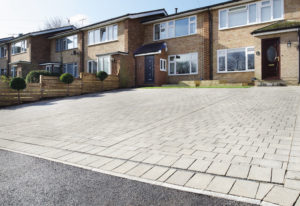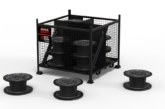
Phil Windus from ACO Technologies delves into drainage channel load classes, and explains why you need to know your A 15’s from your B 125’s.
Drainage channels are a staple product on many new-build developments and extension projects up and down the country. However, viewing them with a ‘one size fits all’ mentality can easily result in the wrong product being installed. Getting to grips with how they’re classified can make a big difference to ensuring housebuilders install what’s most suitable for the job in hand.
Given the country’s tendency to suffer from wet weather all year round, and the subsequent need to shift surface water in a variety of domestic applications – from roads and car parks to driveways and patios – drainage channels are an incredibly common building product.
Often bought by the metre, and generally purchased or specified on price, drainage channels can easily slip into a ‘fit and forget’ category. However, by not taking the time to fully consider the final application, housebuilders can quickly find themselves confronted by disgruntled buyers demanding for the work to be re-done if a product with the wrong load class was installed.
Load classes
In accordance with BS EN 1433:2002, all drainage channels are classified into load classes, which are effectively different categories detailing the load-bearing capacity of that product. Ranging from A 15 for pedestrian footpaths and patios, through to F 900 for airports and industrial yards, the system is a quick way of ensuring that, if you are fitting out a driveway or a patio, the right channel and grating – i.e. one that will stand up to the rigours of the application – is selected.
However, while the load class system itself is a fairly simple specification tool to follow, it’s one that surprisingly few people are fully up to speed with.
Let’s put the issue into context. A 15 is the most commonly used drainage channel, and a staple commodity that housebuilders often buy again and again due to its familiarity, availability, and cost. If we take a typical scenario of a new build property, or even a garden and driveway renovation, then A 15 drainage channels would be suitable for use on pathways and patios.
However, where the issues begin to arise is when an A 15 channel is installed at the entrance or in the middle of a driveway. In short, A 15 should not be used in these scenarios as the product does not have the load-bearing capacity to withstand the pressure of a car turning on it (as is a common occurrence at the entrance for most driveways) or if a delivery van or bin lorry pulled up outside the house and parked on it. Here, the material would soon buckle under the pressure and start to break apart, both turning it into a potential hazard and generally losing its aesthetic feel.
It is worth remembering here that you cannot escape the fact that looks are a key factor when it comes to building work, and buyers will rightly be angry if their new property or driveway renovation is marred by broken drainage grates just a few months after being finished.
In this instance, a B 125 channel would be best. It is the next load class up, has a higher load-bearing capacity and comes in at only a slightly higher price per metre than an A 15 channel. Importantly, it’s generally readily available in merchants alongside its A 15 counterpart.
This is where having that extra in-depth product knowledge around drainage load classes can make a difference between the right or wrong product being installed first time around.
Car parks
While A 15 and B 125 may be the most commonly bought drainage channels, the same principle applies to all load classes and applications. For instance, if the housebuilder was also responsible for building any flats as part of the development then B 125 would be sufficient for a small car park mainly used by domestic vehicles.
However, if it were a large carpark open to the public, such as one supporting municipal facilities within a housing estate such as a row of shops or a library, where vans or commercial vehicles could feasibly park, then either a C 250 or D 400 solution is likely to be the best option.
In short, whilst drainage channels might seem like a commodity product, there’s much more to them than that. By cross-referencing the intended end-use with the load class and limitations of each product, housebuilders can ensure the right drainage solution for the application in question is installed. It might not seem like a big thing, but it will go a long way to keeping your buyers happy, and ensuring a job only ever needs to be done once.
For more information on ACO Technologies’ range of drainage solutions click here.










